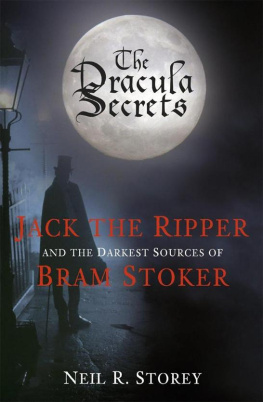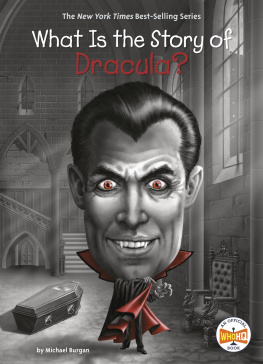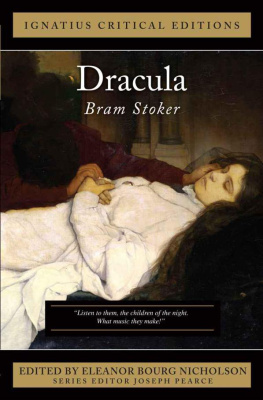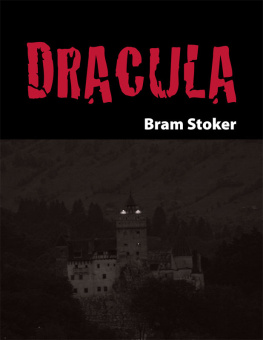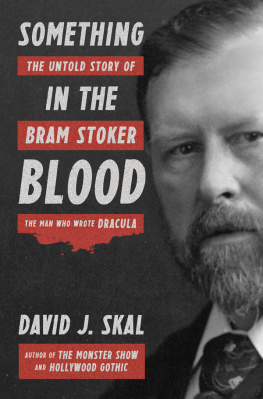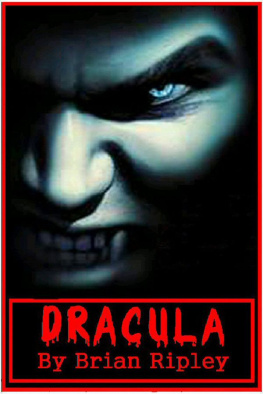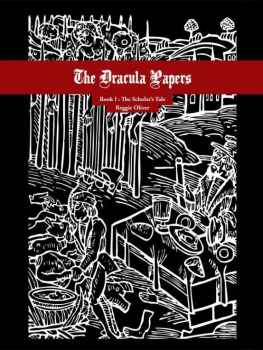
For Molly My angel of the darkness
C ONTENTS
by Stewart P. Evans |
Chapter 1 |
Chapter 2 |
Chapter 3 |
Chapter 4 |
Chapter 5 |
Chapter 6 |
Chapter 7 |
Chapter 8 |
Chapter 9 |
Chapter 10 |
Appendix 1 | : Character Profile Based on the Expert Analysis of the Letters of Francis Tumblety |
Appendix 2 | Listed by Bram Stoker in his Research Notes for Dracula |
Appendix 3 | to Castle Dracula Klausenburg to Bistritz A Suggested Source |
Appendix 4 | A Chat with the Author of Dracula |
Appendix 5 | , Esq (Deceased) |
(With a digression on Ripper research)
By Stewart P. Evans
In any list of literary and film subjects that have acquired cult status the names of Jack the Ripper and Dracula must figure prominently. The former, although his identity remains unknown, was a real-life murderer, but he is one who has attracted great mythology and fictional trappings; the latter character is fictional but he has attracted much research in an effort to establish a real historical basis. Both rank highly as nightmare figures that continue to haunt the imagination. To seek actual links between the two is an intriguing quest, which has never before been fully explored. The author of the present work, however, has sought out some very real associations and presents his findings here, adding new facts to our knowledge. In this computer age of digital online searching, when many researchers and writers seldom stray from their keyboards, Neil Storey has travelled widely researching his subject.
In presenting his work, the author grounds his findings on much solid biographical and genealogical information and gives us an excellent insight into those dark Victorian days of the fin de sicle , when London was subjected to a reign of terror the like of which had not been seen before. He seeks out all the players; Bram Stoker, Henry Irving, Hall Caine, Francis Tumblety and others, and adds to our knowledge. In the pages of the contemporary press the London exploits of the unknown Jack the Ripper were broadcast to a horrified nation and, indeed, to the world. In the pages of an 1897 novel the London exploits of the fictional Count Dracula were likewise broadcast to the nation and the world. Both were the subjects of stage plays and, later, films. The infamy of both grew and spread over the years in equal measure. Both attracted a cult following, which has now migrated to the Internet. In an age when codes, esoteric associations and mysterious links are very popular, is it really possible to establish anything of a tangible nature to link Jack the Ripper with Count Dracula? Well, I believe that Neil Storey has shown us that it really is and that cannot be gainsaid. We know that Bram Stoker was in London during the relevant period and that the murders attracted his attention. The problem is, however, to try and establish firm connections between the Ripper (described at the time as a vampire and drunk with blood) and Stokers fictional blood-feasting Count. It must be no mere coincidence that Stoker had Dracula venturing into the East End of London.
Both subjects have been of great interest to me almost as far back as I care to remember. I recall first reading about Jack the Ripper in 1961 and around the same time I read Bram Stokers novel about the sanguinary Count. Although I have never published anything on Dracula I have followed the associated literature and movies over the years. My interest in Jack the Ripper has, however, been the object of much reading and research for me for just as long and I have published several works on the subject; I may be entitled to at least claim to be an authority in the field. Back in 1993 sheer serendipity led to my discovery of a fresh and genuine contemporary Ripper suspect, one Dr Francis Tumblety, an Irish-American, and this led to my first Ripper book, co-authored with Paul Gainey, some two years later.
This is not a book seeking to establish the identity of Jack the Ripper, although it does cast some interesting sidelights on that vexed question. It also provides new and relevant information on the decidedly odd Francis Tumblety M.D., a genuine Ripper suspect of the time. It enhances our understanding of those fraught times and the characters playing out the drama. Of its nature no book that makes out the best case for any particular individual being Jack the Ripper can hope to be totally objective. It is, naturally, subjective. It is therefore necessary to be selective with contemporary press material as well as to indulge in speculation. Even so, honesty and accuracy should be maintained and all relevant material, where known, should be included. I endeavoured to follow these requirements but it did not prevent me from being labelled the Tumblety man. This is a tag that I have found very difficult to shake off, despite the totally objective reference works I have since written. I have stated my position over this question in order to explain my own lack of research into Tumblety since the publication of the updated edition of my book in 1996. I felt that the best research on Tumblety would be carried out by those better placed than myself to do so and to maintain objectivity it was better for me to not indulge one suspect. The USA was where the best material was to be found. Many researchers took up the torch and some excellent research was carried out by such dedicated souls as Joe Chetcuti, Mike Hawley, Roger Palmer, Tim Riordan and Wolf Vanderlinden. They have all added greatly to our knowledge. Dracula and Stoker, too, have their champions of research and much relevant material and opinion has been added by such dedicated followers as Barbara Belford, Richard Dalby, Carol Margaret Davison, Robert Eighteen-Bisang, the late Dan Farson (who also contributed greatly on Jack the Ripper), Radu Florescu and Raymond McNally, Clive Leatherdale, Harry Ludlam, Elizabeth Miller, Paul Murray, my old and valued friend the late Leslie Shepard, Leonard Wolf and others too numerous to mention.
Neil Storey has bravely taken up the diverse threads and has looked at Tumbletys connection, and possible links, with the relevant cast of Victorian characters. To forge a real link between the factual Jack the Ripper and the fictional Dracula adds, in my opinion, great interest to both, but it is a daunting task and I can only admire his dedication to the cause. All that said, I feel that this book is a valuable addition to both areas of interest and I recommend it to the relevant readers as a necessary addition to their (probably creaking) bookshelves.
This book has been made possible and enriched by many who have generously opened their archives and shared their knowledge with me. I am particularly indebted to a man I am proud to call my friend, crime historian Stewart P. Evans. I would also like to express my gratitude to Manx National Heritage Eiraght Ashoonagh Vannin and particularly their archivist Wendy Thirkettle. It is thanks to the generosity of Manx National Heritage that many of the letters sent by Francis Tumblety to Thomas Henry Hall Caine are published for the first time in this book.
I would also like to record my appreciation and thanks to the following: Heather Wolfe and Rebecca Oviedo at Folger Shakespeare Library, Washington; Nicole Contaxis, The New-York Historical Society; Karen Schoenewaldt, Registrar at Rosenbach Museum & Library, Philadelphia; Shakespeare Centre Library and Archive, Stratford-upon-Avon; Claire-Hlne Lengell, Marie-Chantal Anctil and Suzanne Grgoire at Bibliothque et Archives Nationales du Qubec; Paul Hambleton, National Library of Scotland; The Victorian and Albert Museum; The British Library; The National Archives; The Library of Congress; United States National Archives, War Department Records, Judge Advocate General Office; Legislative Library of New Brunswick; The Library and Archives of Trinity College Dublin, Trinity College Dublin Historical Society (The Hist); Whitby Museum & Library; Whitby Public Library; St Marys Parish church, Whitby; Whitby Abbey; Michael Shaw, The Sutcliffe Gallery, Whitby; Golders Green Crematorium; Norfolk Library and Information Service; Sothebys London; Liverpool Record Office, Carol Collins; Ruth Myers; Helen Tovey at Family Tree Magazine ; Joe Chetcuti; Robert Eighteen-Bisang; Clive Leatherdale; James Nice; Roger Palmer; Robert Smith; Jo de Vries, Mark Beynon and Cate Ludlow at The History Press; Colin Wilkinson, Bluecoat Press, Liverpool; Rusty Clark; David Drummond; Donald Rumbelow; Andrew Selwyn-Crome; Martin and Pip Faulks; the late Leslie Shephard and The Walt Whitman Archive, edited by Ed Folsom and Kenneth M. Price, published by the University of NebraskaLincoln http://www.whitmanarchive.org/ .
Next page
